Iron Maiden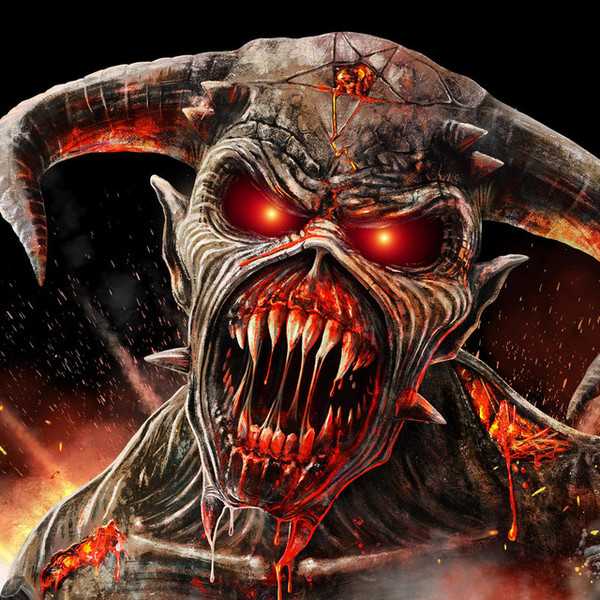 | ||
| Allmusic Biography : Known for such powerful hits as "Two Minutes to Midnight" and "The Trooper," Iron Maiden are one of heavy metals most influential bands. Theyre also one of metals most enduring and distinctive acts, thanks to their melodic guitars, ambitious songwriting, powerhouse vocalist Bruce Dickinson, and iconic mascot Eddie. One of the first groups to be classified as "British metal," Iron Maiden helped set the rock scene for the 80s and inspired generations of subsequent bands, including Metallica, Dream Theater, Slipknot, In Flames, and Avenged Sevenfold. Despite a lack of radio airplay or mainstream media support, early allegations of Satanism, and a revolving lineup, they have remained consistently popular throughout their career. Iron Maiden were formed in 1975 in Leyton, East London by bassist Steve Harris, formerly of the band Smiler. The groups lineup was volatile during its early years, but eventually settled on drummer Doug Sampson, guitarist Dave Murray, and vocalist Paul DiAnno in 1978. Late that year, this incarnation of the band recorded a four-song demo and circulated it to club owners and others involved in the London scene, including the groups soon-to-be manager Ron Smallwood. The demos popularity led Iron Maiden to self-release it as 1979s The Soundhouse Tapes EP, which soon sold out its 5,000-copy run. After scoring a deal with EMI, the band enlisted a second guitarist, Dennis Stratton. Late in 1979, Sampson departed due to health issues and former Samson drummer Clive Burr took his place behind the kit. The bands self-titled debut arrived in 1980; though it was recorded in a hurry, it was nonetheless a U.K. hit due to the single "Running Free." Its 1981 follow-up, Killers, had a harder approach thanks in part to producer Martin Birch -- with whom the group worked until his 1992 retirement -- and also saw the replacement of Stratton with Murrays childhood friend Adrian Smith. Due to substance abuse issues, DiAnno was dismissed from Iron Maiden after the Killer World Tour in 1981. His replacement was Bruce Dickinson, another former Samson member who joined that September and made his recorded debut with the band on 1982s groundbreaking The Number of the Beast. Boasting songs such as the title track and "Hallowed Be Thy Name," it became known as one of the all-time great rock albums. Though it was the bands first chart-topping album in the U.K. and was a Top Ten seller in several other countries, Christian activists and conservative politicians in America claimed the band was Satanic (which Iron Maiden denied). Nevertheless, The Number of the Beasts success made Iron Maiden international superstars, and despite the replacement of Burr with former Trust drummer Nicko McBrain, they changed very little of their style on 1983s Piece of Mind. The band undertook two major tours before recording 1984s Powerslave, which would go on to be another cult hit and featured the 13-minute epic "The Rime of the Ancient Mariner," which was inspired by Samuel Taylor Coleridges poem. The product of Powerslaves 11-month tour was 1985s Live After Death, a double-live album featuring their biggest hit singles. Now established as a powerful and unique metal band, Iron Maiden experimented on their long-awaited 1986 album, Somewhere in Time, incorporating synthesized bass and guitar and futuristic themes. They continued to expand their sound and subject matter with 1988s Seventh Son of a Seventh Son. Another concept album featuring the singles "The Evil That Men Do" and "The Clairvoyant," as well as the bands first use of keyboards, it was Maidens most critically acclaimed album since The Number of the Beast. After that albums release, Smith and Dickinson worked on their own projects: Smiths album with his band ASAP arrived in 1989, while Dickinsons solo album, Tattooed Millionaire, appeared the following year. When Iron Maiden reconvened to work on a new album, Smith left over creative differences; ex-Gillan guitarist Janick Gers, who played on Tattooed Millionaire, joined the fold for 1990s No Prayer for the Dying. A return to the bands stripped-down sound of the early 80s, it gave Iron Maiden their first number one U.K. single with "Bring Your Daughter...To the Slaughter." At the end of the bands 1991 tour, Dickinson expressed his desire to leave and work on his own music. However, he recorded another album, 1992s Fear of the Dark, and toured with the band, ultimately leaving in 1993. That year, two live albums were released: A Real Live One, which focused on their contemporaneous hit singles, and A Real Dead One, which featured Maidens classic songs. Iron Maiden took some time off after Dickinsons departure, returning with 1995s The X Factor, which featured new singer and ex-Wolfsbane member Blaze Bayley. While the record didnt perform as well commercially as some of its predecessors, it was still a success in England. Its follow-up, 1998s Virtual XI, was one of the bands lowest-selling albums; in addition, Bayley was having issues with his voice, and he left Iron Maiden early in 1999. Soon after, Dickinson and Smith returned to the group, who released the ambitious, Kevin Shirley-produced Brave New World the following year. Iron Maiden remained reinvigorated throughout the 2000s, touring and recording almost as consistently as they did in the 80s. They reunited with Shirley for 2003s critically acclaimed Dance of Death, which was inspired by battles ranging from the conquering of a 13th century Cathar stronghold ("Montségur") to a notable World War I campaign ("Paschendale"). The Rainmaker EP, as well as the live DVDs History of Iron Maiden, Pt. 1: The Early Days and Raising Hell, followed in 2004. Sanctuary put out the two-disc The Essential Iron Maiden in 2005 to coincide with their gig co-headlining an Ozzfest tour with Black Sabbath, which the band left due to a series of confrontations with Ozzys wife/manager, Sharon. Another live set, Death on the Road, appeared in September of 2005, shortly before Iron Maiden returned to the studio to work on their 14th album. The results were 2006s A Matter of Life and Death, the bands first album to enter the Top Ten of the Billboard 200. Three years later, Iron Maiden released the soundtrack for the film Flight 666, a documentary/concert film recorded in 16 different cities during Maidens first leg of their 2008 Somewhere Back in Time World Tour, which saw the band traveling in a customized Boeing 747 (called Ed Force One) flown by Dickinson, who is also a licensed pilot. Iron Maiden worked with Shirley once again on 2010s The Final Frontier, which reached the top of the charts in 28 countries and earned the band a Grammy Award for Best Hard Rock/Metal Performance for the single "El Dorado." It was followed in 2012 by En Vivo!, a live video/album filmed at Estadio Nacional, Santiago, Chile in April 2011. In 2013, the band began work on its 16th studio album, with plans to release it in 2015. Though the album was completed, the discovery of cancerous tumors on Dickinsons tongue and neck in late 2014 slowed things down. He underwent rigorous chemotherapy. He was declared cancer-free in May of 2015. Iron Maiden put the finishing touches on the album and issued the video pre-release single "Speed of Light" in August. The 92-minute, double-length album Book of Souls followed in September. In 2016 and 2017 the band set out on the Book of Souls World Tour in support of the album, and later released the live collection Book of Souls: Live Chapter, which was recorded during the tour. | ||
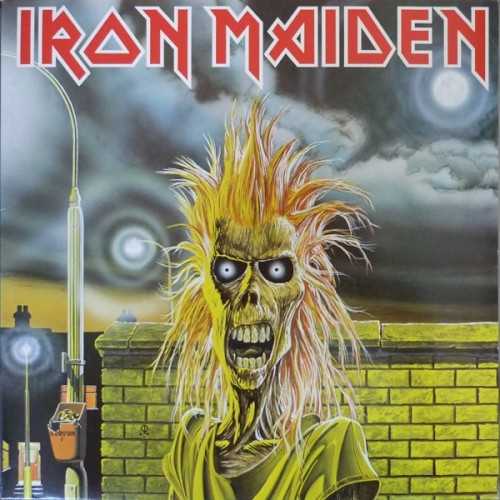 | Album: 1 of 27 Title: Iron Maiden Released: 1980-04-14 Tracks: 8 Duration: 37:41 Scroll: Up Down Top Bottom 25% 50% 75% Spotify Wikipedia Allmusic AlbumCover | 1 Prowler (03:56) 2 Remember Tomorrow (05:28) 3 Running Free (03:17) 4 Phantom of the Opera (07:20) 5 Transylvania (04:05) 6 Strange World (05:46) 7 Charlotte the Harlot (04:12) 8 Iron Maiden (03:35) |
| Iron Maiden : Allmusic album Review : There may be no better place to hear how both punk and prog rock informed the New Wave of British Heavy Metal than Iron Maidens self-titled debut. Often overlooked and overshadowed by the glorious Bruce Dickinson years, its easy to forget that Iron Maiden was itself a game-changer when it appeared on the scene in 1980. That year also saw important albums from Motörhead, Saxon, and Angel Witch, but Iron Maiden vaulted its creators to the head of the NWOBHM pack, reaching the U.K. Top Five and establishing them as an outfit with the talent to build on Judas Priests late-70s innovations. On the one hand, Maiden was clearly drawing from elements of punk rock -- the raw D.I.Y. production, the revved-up velocities, and the vocals of rough-and-ready growler Paul DiAnno, who looked and sounded not like a metal god, but rather a short-haired street tough. On the other hand, Maiden had all the creative ambition of a prog rock band. Compositionally, even their shortest and most straightforward songs featured abrupt changes in tempo and feel. Their musicianship was already light years beyond punk, with complicated instrumental passages between guitarists Dave Murray and Dennis Stratton and bassist Steve Harris. When Murray and Stratton harmonize their leads, they outdo even Priests legendary tandem in terms of pure speed. The lyrics have similarly high-flying aspirations, spinning first-person stories and character sketches with a flair for the seedy and the grotesque. Add it all up, and Iron Maiden performs the neat trick of reconciling two genres seemingly antithetical to one another, using post-Priest heavy metal as the meeting ground. The seven-minute "Phantom of the Opera" is a landmark, the bands earliest progressive epic and still among its best; with its ambitious fusion of musical styles, its multi-sectioned construction, and the literary retelling of the lyrics, it seemed to encapsulate all the promise of both the band and the NWOBHM. Two of the simpler, punkier rockers, "Running Free" and "Sanctuary" (the latter left off the U.K. version but added to subsequent reissues), made the lower reaches of the British singles charts. The flasher tale "Prowler," one of the bands more enduring numbers, is in the same vein, but ups the instrumental complexity, while the title track still remains a concert staple. Elsewhere, the band offers the first of many instrumentals with "Transylvania," introduces the recurring title character of "Charlotte the Harlot," and reimagines Judas Priests "Beyond the Realms of Death" with the "ballad" "Remember Tomorrow," which starts out soft but closes with a speed-freak guitar section. Perhaps the only hint of a misstep comes on the more restrained ballad "Strange World," the only song from this album that was never re-recorded in a live or alternate version by the Dickinson lineup. Nonetheless, the whole project explodes with energy and ideas, and while the band would certainly go on to refine much of whats here (including the cover painting of mascot Eddie), Iron Maiden would still rank as a landmark even if the Dickinson years had never happened. | ||
 | Album: 2 of 27 Title: Killers Released: 1981-02-02 Tracks: 10 Duration: 38:43 Scroll: Up Down Top Bottom 25% 50% 75% Spotify Wikipedia Allmusic AlbumCover | 1 The Ides of March (01:46) 2 Wrathchild (02:55) 3 Murders in the Rue Morgue (04:18) 4 Another Life (03:22) 5 Genghis Khan (03:07) 6 Innocent Exile (03:52) 7 Killers (05:01) 8 Prodigal Son (06:11) 9 Purgatory (03:20) 10 Drifter (04:48) |
| Killers : Allmusic album Review : Iron Maidens sophomore effort, Killers, is mostly composed of pre-existing material that had been left off the debut, with just a few new additions. Its certainly a better-sounding release than the debut, with new producer Martin Birch beefing up the bands studio presence and lending their instrumental attack a newfound clarity that throws their considerable skills into sharp relief. In fact, this helps mask the fact that the songwriting isnt quite as strong overall as it was on the debut. But the teaming of new guitarist Adrian Smith with Dave Murray forms the most formidable twin-guitar attack in heavy metal, outside of Glenn Tipton and K.K. Downing. Plus, bassist Steve Harris busy, driving lines are now consistently audible in the mix. The resulting instrumental fireworks are what truly make the album tick. That said, theres a much smaller percentage of catalog standards here than on the previous album. "Wrathchild" is the standout, re-recorded here with Smith on guitar from an earlier version for the Metal for Muthas compilation. Theres a fair bit of unity in the lyrical themes, with a parade of murderers, fugitives, and characters otherwise torn from their roots. "Murders in the Rue Morgue" is a first-person retelling of the Poe short story, and the title track is another highlight, with Paul DiAnno turning in an especially menacing performance. The single "Purgatory" has a catchy singalong chorus and a tempo worthy of Motörhead, while "Twilight Zone" (not included on the U.K. issue, but added to subsequent releases) scraped the bottom of the British charts. The biggest departure here is the almost Supertramp-like prog-pop of "Prodigal Son," a melodic, uptempo offering with an arrangement based around acoustic guitars. Despite some inconsistency in the material, Killers is clearly the work of a top-notch ensemble, and in order to take the next step forward, their musical ambitions were clearly going to require a vocalist as technically accomplished as the band. Its worth noting that some Maiden fans actually prefer the rawness of the DiAnno years to the polish of the Bruce Dickinson era (though, it should also be noted, theyre in the minority). | ||
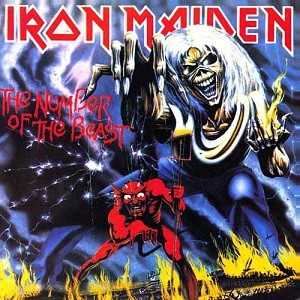 | Album: 3 of 27 Title: The Number of the Beast Released: 1982-03-29 Tracks: 10 Duration: 50:17 Scroll: Up Down Top Bottom 25% 50% 75% Spotify Allmusic AlbumCover | 1 Invaders (03:23) 2 Children of the Damned (04:34) 3 The Prisoner (06:02) 4 22, Acacia Avenue (06:36) 5 The Number of the Beast (04:51) 6 Run to the Hills (03:53) 7 Gangland (03:48) 8 Hallowed Be Thy Name (07:11) 1 Total Eclipse (04:27) 2 Remember Tomorrow (05:27) |
| The Number of the Beast : Allmusic album Review : Routinely ranked among the greatest heavy metal albums of all time, The Number of the Beast is the birth of Iron Maiden as we know it, a relentless metal machine lifted to soaring new heights by the arrival of erstwhile Samson frontman Bruce Dickinson. Dickinsons operatic performance here made him an instant metal icon, challenging even Rob Halford for bragging rights, and helped launch the band into the stratosphere. The Number of the Beast topped the charts in the U.K., but even more crucially -- with Judas Priest having moved into more commercial territory -- it also made Iron Maiden the band of choice for purists who wanted their metal uncompromised. Maiden took the basic blueprint Priest had created in the late 70s -- aggressive tempos, twin-guitar interplay, wide-ranging power vocals -- and cranked everything up faster and louder. The albums intensity never lets up, the musical technique is peerless for its time, and there isnt a truly unmemorable song in the bunch. Blessed with a singer who could drive home a melody in grandiose fashion, Steve Harris writing gets more ambitious, largely abandoning the street violence of old in favor of fittingly epic themes drawn from history, science fiction, and horror. The exceptions are "22 Acacia Avenue," a sequel to "Charlotte the Harlot" that sounds written for DiAnnos range, and the street-crime tale "Gangland," which Harris didnt write; though the punk influences largely left with DiAnno, these two definitely recall the Maiden of old. As for the new, two of the bands (and, for that matter, heavy metals) all-time signature songs are here. The anthemic "Run to the Hills" dramatized the conquest of the Native Americans and became the bands first Top Ten U.K. single. It features Maidens trademark galloping rhythm, which in this case serves to underscore the images of warriors on horseback. Meanwhile, the title tracks odd-meter time signature keeps the listener just slightly off balance and unsettled, leading into the most blood-curdling Dickinson scream on record; the lyrics, based on nothing more than Harris nightmare after watching a horror movie, naturally provoked hysterical accusations of Satan worship (which, in turn, naturally provoked sales). "Hallowed Be Thy Name" is perhaps the most celebrated of the bands extended epics; its the tale of a prisoner about to be hanged, featuring some of Harris most philosophical lyrics. It opens with a superbly doomy atmosphere before giving way to a succession of memorable instrumental lines and an impassioned performance by Dickinson; despite all the tempo changes, the transitions never feel jarring. Elsewhere, "The Prisoner" is a catchy retelling of the hit British TV series, and "Children of the Damned" is a slower, heavier number patterned after the downtempo moments of Dio-era Black Sabbath. CD remasters integrate "Total Eclipse," first released as the B-side of "Run to the Hills," into the running order. Though some moments on The Number of the Beast are clearly stronger than others, the album as a whole represented a high-water mark for heavy metal, striking a balance between accessible melodicism and challenging technique and intensity. Everything fell into place for Iron Maiden here at exactly the right time, and the result certainly ranks among the top five most essential heavy metal albums ever recorded. A cornerstone of the genre. | ||
 | Album: 4 of 27 Title: Piece of Mind Released: 1983-05-16 Tracks: 9 Duration: 45:58 Scroll: Up Down Top Bottom 25% 50% 75% Spotify Wikipedia Allmusic AlbumCover | 1 Where Eagles Dare (06:10) 2 Revelations (06:48) 3 Flight of Icarus (03:51) 4 Die With Your Boots On (05:28) 5 The Trooper (04:12) 6 Still Life (04:53) 7 Quest for Fire (03:41) 8 Sun and Steel (03:26) 9 To Tame a Land (07:27) |
| Piece of Mind : Allmusic album Review : The second of three straight iconic Iron Maiden albums, Piece of Mind marks the debut of what many regard as the definitive Maiden lineup, with the arrival of new drummer Nicko McBrain. McBrains ability to duplicate the complex patterns of the guitar and bass riffs gives the band a seamless ensemble unity. Even Steve Harris, whose busy basslines were never exactly groove-oriented, has never felt more integrated into the overall sound. Perhaps part of that feeling comes from the less frantic pace; the average tempo has slowed somewhat from the preceding album, and the hold-over punk influences still present there have been completely eradicated. Instead, we get a few moodier, heavier pieces (especially "Revelations") that make the album darker-sounding overall. We also get greater involvement in the songwriting from Bruce Dickinson and Adrian Smith, whose themes are perfectly in tune with Steve Harris epic storytelling. Nearly every song here was inspired by movies or literature, whether its history, mythology, sci-fi, or fantasy; this approach got them tagged as a thinking-mans metal band, and certainly provided a lyrical blueprint for Anthrax. No less than four songs are about battles and warriors, and a couple are about flying, underscoring the heights of the drama that the band is aiming for. The centerpiece of the album is, of course, "The Trooper," an all-time genre classic that boasts Murray and Smiths most memorable harmonized lead riff, plus that trademark galloping rhythm. A retelling of the Greek myth "Flight of Icarus" was the other British hit single, boasting an appropriately soaring chorus. Album opener "Where Eagles Dare" is the other flight song, recounting a WWII spy thriller and featuring one of McBrains signature performances with the band. If much of Piece of Mind ranks as state-of-the-art heavy metal, it is true that the second half dips a bit from the first. "Quest for Fire" is many a die-hard fans least favorite track from the glory years; the melody is rather stiff and simple, and the lyrics are about cavemen, rendering Dickinsons operatics ("In a tiiiiiime when dinosaurs walked the eaaaaaarth") a bit ridiculous. Among the serious-minded Maiden faithful, theres no less forgivable sin than silliness (no matter how entertaining it might be). Fans also bemoan the relative simplicity of the samurai tale "Sun and Steel." However, the album closes on a big, progressive note with "To Tame a Land," an epic retelling of Frank Herberts Dune that evokes the desert planet via Middle Eastern guitar melodies. In the end, even if Piece of Mind is the most obviously inconsistent of the classic Maiden trilogy, its many high points are no less awe-inspiring, and its no less essential for anyone with even the most basic interest in heavy metal. | ||
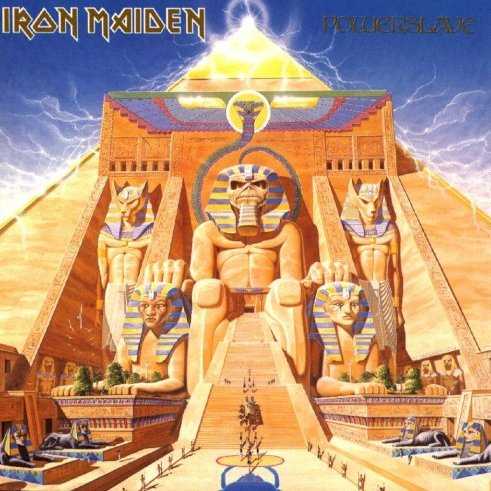 | Album: 5 of 27 Title: Powerslave Released: 1984-09-03 Tracks: 8 Duration: 51:04 Scroll: Up Down Top Bottom 25% 50% 75% Spotify Wikipedia Allmusic AlbumCover | 1 Aces High (04:31) 2 2 Minutes to Midnight (06:01) 3 Losfer Words (Big ’Orra) (04:15) 4 Flash of the Blade (04:05) 5 The Duellists (06:09) 6 Back in the Village (05:05) 7 Powerslave (07:13) 8 Rime of the Ancient Mariner (13:41) |
| Powerslave : Allmusic album Review : The third in a trilogy of legendary Iron Maiden albums, Powerslave is frequently ranked as the fan favorite of the bunch, capping off a stellar run that sealed the bands genre-defining status. If The Number of the Beast was the all-time metal landmark, Powerslave is perhaps the quintessential Maiden album, capturing all the signature elements of the bands definitive era in one place. The album opens with Maiden at their catchiest, turning in a pair of metal classics right off the bat with the British hit singles "Aces High" (a high-speed ode to a WWII air battle) and the apocalyptic "2 Minutes to Midnight." Next we get an instrumental, "Losfer Words (Big Orra)," of the sort that Maiden periodically deployed to keep fans in awe of their technical chops. A pair of their best and most overlooked album tracks follows; "Flash of the Blade" and "The Duellists" exemplify the glory-minded battle hymns that made up such an important part of their lyrical obsessions, even if both are about sword fighting rather than modern military history. By the end of the album, were seeing Maiden at their most progressive and ambitious. The seven-minute title track builds on the previous albums "To Tame a Land" with its use of Middle Eastern melodies, delving into Egyptian mythology for a rumination on power and mortality. This leads into the biggest, most grandiose epic in the Maiden catalog -- "Rime of the Ancient Mariner," a multi-sectioned, thirteen-and-a-minute prog-fest adapted from the Samuel Taylor Coleridge poem. Though it isnt exactly what youd call hooky, its shifting moods and lofty intellectual aspirations made it a live favorite. This latter material helped ensure that Powerslave was the Maiden album with the biggest impact on the emerging progressive metal genre (which, in its earliest form, essentially fused Rush with this sort of Maiden material). In this context, "Back in the Village" gets somewhat lost in the shuffle; its a thematic sequel to "The Prisoner," though not quite as memorable. So even though we dont hear the punk influences of old, Powerslave catalogs every major facet of the bands personality during the Dickinson years, and does so while firing on all cylinders. Perhaps thats in part because Powerslave is the first Maiden album to feature the same lineup as its predecessor, creating a definite continuity and comfort level. Or perhaps its simply that were witnessing a great band in its creative prime. Whatever the case, its entirely arguable that Powerslave summarizes why Iron Maiden was so important and influential even more effectively than The Number of the Beast, at least on a purely musical level. It may not be quite as accessible, but its every bit as classic and essential. | ||
 | Album: 6 of 27 Title: Somewhere in Time Released: 1986-06-29 Tracks: 8 Duration: 51:24 Scroll: Up Down Top Bottom 25% 50% 75% Spotify TrackSamples Wikipedia Allmusic AlbumCover | 1 Caught Somewhere in Time (07:25) 2 Wasted Years (05:07) 3 Sea of Madness (05:41) 4 Heaven Can Wait (07:21) 5 The Loneliness of the Long Distance Runner (06:31) 6 Stranger in a Strange Land (05:44) 7 Deja-Vu (04:56) 8 Alexander the Great (08:35) |
| Somewhere in Time : Allmusic album Review : The weakest album from Iron Maidens classic ‘80s period, Somewhere in Time is really the first true disappointment in their catalog, too often collapsing under the weight of their now-trademark ambition. Though it sold well on the heels of the hugely successful Powerslave tour, and is often regarded as underrated by Maiden devotees, it clearly finds the band struggling to refresh what was rapidly hardening into formula. Trying to keep up with the times, Maiden incorporate synthesizers here, much as Judas Priest attempted to do on the same years sterilized-sounding creative flop Turbo; the main difference here is that Maiden pull it off much more effectively. Yes, the production does have more of that typically ‘80s studio sheen, but Maiden makes the new instrumentation serve their existing sound, rather than trying to hop on contemporary trends. (And really, why make the sound more commercial when youre already amassing a small fortune from merchandising?) Their ferocity hasnt gone anywhere either, as this ends up their fastest album (on average) since The Number of the Beast. The real problem here is that the material is less inspired; too often Somewhere in Time feels like epic-Maiden-by-numbers, as fewer of the extended pieces truly catch hold. The first half of the album actually works very well -- "Caught Somewhere in Time" is an effective opener, introducing the newly futuristic flavor in the bands sound while offering a thematic parallel about time travel. Adrian Smith really comes into his own as a writer here, penning both of the albums singles ("Wasted Years," the undisputed highlight here, and "Stranger in a Strange Land," surprisingly not based on Robert A. Heinleins sci-fi classic), plus the nicely metallic "Sea of Madness." Though it perhaps could have been trimmed a bit, "Heaven Can Wait" remained a concert singalong staple for years to come. But then the misfires take over. "The Loneliness of the Long Distance Runner" is far and away the least suitable subject for an extended epic that the band has ever undertaken, and the music itself offers little catharsis. Despite the wailing chorus, "Déjà Vu" never quite gels, feeling a bit underdeveloped musically. The now-expected prog-metal album closer this time is "Alexander the Great," and this part of the Maiden formula here verges on self-parody. Steve Harris lyrics largely stick to a recitation of facts, names, and places that add little drama to the music, and Dickinson is stuck belting out a lazy, totally on-the-nose chorus ("Aaaaaaalexander the Greaaaaaat!"). Somewhere in Time will appeal more to the metal diehard whos already suspicious of too much overt melody; theres plenty of progressive complexity here to impress that type of listener. For the rest of us, even though fully half of the album is still excellent, Somewhere in Time is the first Maiden record thats less than godlike. | ||
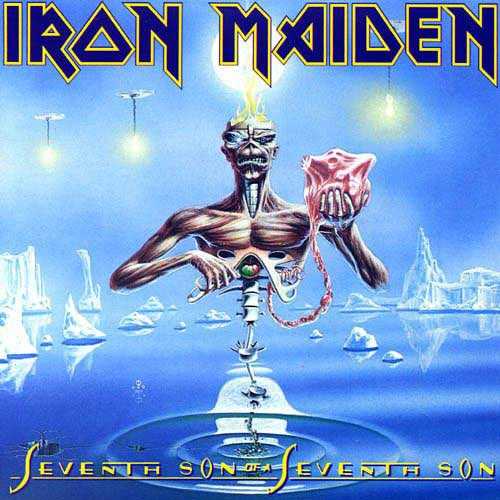 | Album: 7 of 27 Title: Seventh Son of a Seventh Son Released: 1988-04-11 Tracks: 8 Duration: 44:07 Scroll: Up Down Top Bottom 25% 50% 75% Spotify Wikipedia Allmusic AlbumCover | 1 Moonchild (05:41) 2 Infinite Dreams (06:09) 3 Can I Play With Madness (03:32) 4 The Evil That Men Do (04:35) 5 Seventh Son of a Seventh Son (09:53) 6 The Prophecy (05:05) 7 The Clairvoyant (04:27) 8 Only the Good Die Young (04:42) |
| Seventh Son of a Seventh Son : Allmusic album Review : Seventh Son of a Seventh Son is the last great Iron Maiden album, reconnecting with the bands prog rock roots and reversing the signs of decline that had been evident on their previous record. By this point, Maiden had earned the respect of metalheads the world over with their steadfast adherence to unadulterated metal and their grandiose aesthetic. Theyd made concessions neither to pop-metal nor to thrash, and their passionate fan base would never have tolerated a radical reinvention. But what do you do when your epic ambition itself has become a formula? You go even bigger and make a concept album, of course, and thats what Maiden does here, breaking out of the creative rut theyd fallen into on Somewhere in Time. The concept is based on the European folklore which held that the seventh son of a seventh son would be born with special powers that could be used for good or evil (and probably also in part by fantasy author Orson Scott Card, whod touched on this idea in his own work). As such, the lyrics are Maiden at their most gothic, obsessed with supernatural mysticism of all stripes; the story line concerns the title character, born with a gift for prophecy but mistrusted by his village, which ignores his warnings of apocalyptic doom and makes him a tormented Cassandra figure. Musically, this is Maiden at their proggiest, with abrupt, stop-on-a-dime transitions between riffs, tempos, time signatures, and song sections. Yet nearly every song has a memorable chorus, with only "The Prophecy" falling short in that department. Theyve also switched from the guitar synths of Somewhere in Time to full-fledged keyboards, which are used here more to add atmosphere rather than taking center stage; this restores the crunch that was sometimes lacking in the shinier production of the previous album. No less than four of this albums eight songs reached the British Top Ten in some version (concert standard "Can I Play with Madness," "The Evil That Men Do," "The Clairvoyant," and "Infinite Dreams"), while the album became the bands first U.K. chart-topper since The Number of the Beast. The title track is this albums extended epic (though the songs are longer in general), and its moved out of the closing spot in yet another subtle statement about shaking things up. If Seventh Son doesnt epitomize their sound or define an era the way the first three Dickinson albums did, it nonetheless ranks among their best work. Adrian Smith left the band after this record, closing the book on Maidens classic period and heralding a dire -- and distressingly immediate -- creative decline. | ||
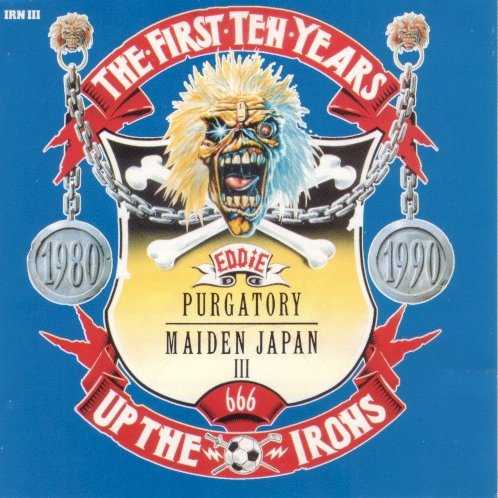 | Album: 8 of 27 Title: The First Ten Years Released: 1990-06-27 Tracks: 64 Duration: 5:40:48 Scroll: Up Down Top Bottom 25% 50% 75% Wikipedia AlbumCover | 1 Running Free (03:17) 2 Burning Ambition (02:41) 3 Sanctuary (03:16) 4 Drifter (06:03) 5 I’ve Got the Fire (live) (03:14) 6 Listen With Nicko! Part I (09:29) 1 Women in Uniform (03:10) 2 Invasion (02:38) 3 Phantom of the Opera (live) (07:12) 4 Twilight Zone (02:34) 5 Wrathchild (02:55) 6 Listen With Nicko! Part II (08:02) 1 Purgatory (03:20) 2 Genghis Khan (03:07) 3 Running Free (03:09) 4 Remember Tomorrow (05:46) 5 Killers (04:51) 6 Innocent Exile (04:02) 7 Listen With Nicko! Part III (07:42) 1 Run to the Hills (03:53) 2 Total Eclipse (04:27) 3 The Number of the Beast (04:51) 4 Remember Tomorrow (05:28) 5 Listen With Nicko! Part IV (08:23) 1 Flight of Icarus (03:51) 2 I’ve Got the Fire (02:39) 3 The Trooper (04:12) 4 Cross‐Eyed Mary (03:53) 5 Listen With Nicko! Part V (09:49) 1 2 Minutes to Midnight (06:01) 2 Rainbow’s Gold (04:56) 3 Mission From ’Arry (06:43) 4 Aces High (04:31) 5 King of Twilight (04:53) 6 The Number of the Beast (live version) (04:59) 7 Listen With Nicko! Part VI (09:45) 1 Running Free (03:28) 2 Sanctuary (04:40) 3 Murders in the Rue Morgue (04:32) 4 Run to the Hills (04:06) 5 Phantom of the Opera (07:28) 6 Losfer Words (Big ’Orra) (04:15) 7 Listen With Nicko! Part VII (11:54) 1 Wasted Years (05:07) 2 Reach Out (03:30) 3 Sheriff of Huddersfield (03:34) 4 Stranger in a Strange Land (05:44) 5 That Girl (05:04) 6 Juanita (03:46) 7 Listen With Nicko! Part VIII (12:20) 1 Can I Play With Madness (03:32) 2 Black Bart Blues (06:40) 3 Massacre (02:53) 4 The Evil That Men Do (04:35) 5 Prowler ’88 (04:07) 6 Charlotte the Harlot ’88 (04:11) 7 Listen With Nicko! Part IX (10:46) 1 The Clairvoyant (live) (04:27) 2 The Prisoner (live) (06:08) 3 Heaven Can Wait (live) (07:09) 4 Infinite Dreams (live) (06:02) 5 Killers (live) (05:01) 6 Still Life (live) (04:38) 7 Listen With Nicko! Part X (11:18) |
 | Album: 9 of 27 Title: No Prayer for the Dying Released: 1990-10-01 Tracks: 14 Duration: 1:01:29 Scroll: Up Down Top Bottom 25% 50% 75% Spotify Wikipedia Allmusic AlbumCover | 1 Tailgunner (04:15) 2 Holy Smoke (03:49) 3 No Prayer for the Dying (04:23) 4 Public Enema Number One (04:13) 5 Fates Warning (04:12) 6 The Assassin (04:35) 7 Run Silent Run Deep (04:35) 8 Hooks in You (04:08) 9 Bring Your Daughter… to the Slaughter (04:44) 10 Mother Russia (05:32) 1 All in Your Mind (04:31) 2 Kill Me Ce Soir (06:16) 3 I’m a Mover (03:29) 4 Communication Breakdown (02:41) |
| No Prayer for the Dying : Allmusic album Review : With their first album of the 90s, Iron Maiden wanted to return to basics. Comparable to their more straightforward early work, No Prayer for the Dying quickly shot up the charts all over the world, but it was clear that the songwriting wasnt up to snuff when compared to such classics as Killers or Number of the Beast. The album also signaled the debut of new guitarist Janick Gers, best known for his stint in Ian Gillans solo band and on Bruce Dickinsons solo album, Tattooed Millionaire. Featuring a pair of U.K. hit singles -- the anti-televangelist diatribe "Holy Smoke" and Maidens lone number one, the controversial "Bring Your Daughter...to the Slaughter" (which was banned by the BBC) -- plus another that should have been issued as a single (the opener, "Tailgunner"), No Prayer as a whole doesnt measure up to the hits. The title track contains an opening too reminiscent of their 1988 single "Infinite Dreams," while other tracks such as "Fates Warning," "Run Silent Run Deep," and "Hooks in You" never catch fire. And even though the epic closer "Mother Russia," "Public Enema Number One," and "Fates Warning" are standouts, they just dont hold up well when compared to past classics. While Maiden retained their solid following elsewhere in the world, No Prayer for the Dying would prove to be their last gold-certified album in the U.S. | ||
 | Album: 10 of 27 Title: Fear of the Dark Released: 1992-05-11 Tracks: 12 Duration: 58:39 Scroll: Up Down Top Bottom 25% 50% 75% Spotify Wikipedia Allmusic AlbumCover | 1 Be Quick or Be Dead (03:24) 2 From Here to Eternity (03:38) 3 Afraid to Shoot Strangers (06:56) 4 Fear Is the Key (05:35) 5 Childhood’s End (04:40) 6 Wasting Love (05:50) 7 The Fugitive (04:54) 8 Chains of Misery (03:37) 9 The Apparition (03:54) 10 Judas Be My Guide (03:08) 11 Weekend Warrior (05:39) 12 Fear of the Dark (07:18) |
| Fear of the Dark : Allmusic album Review : While 1992s Fear of the Dark was definitely more of a return to form for Iron Maiden, it still wasnt quite on par with their exceptional work from the 80s. Easily an improvement over 1990s lackluster No Prayer for the Dying (both musically and sonically), the album debuted on the U.K. charts at number one. The opening "Be Quick or Be Dead" proved Maiden could easily hold their own with younger thrash metal bands, "From Here to Eternity" contained lyrics that seem better fitted for Mötley Crüe, while the expected epic album-closing title track would become a concert staple (all three tracks were released as U.K. singles). While Maiden records of the past would contain an albums worth of first-rate material, Fear of the Dark is again weighed down with too many drab compositions -- "Childhoods End," "Chains of Misery," "Judas Be My Guide," and more. The serene "Wasting Love" proves to be one of Maidens better ballads of the 90s, while the rockers "Fear Is the Key" and "Afraid to Shoot Strangers" are also standouts. Fear of the Dark would be singer Bruce Dickinsons final studio album with the band (until their late-90s reunion), as he publicly voiced that he felt the band had run its course. | ||
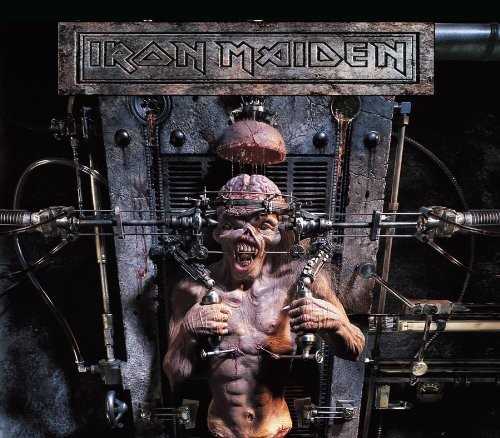 | Album: 11 of 27 Title: The X Factor Released: 1995-10-02 Tracks: 11 Duration: 1:11:06 Scroll: Up Down Top Bottom 25% 50% 75% Spotify Wikipedia Allmusic AlbumCover | 1 Sign of the Cross (11:17) 2 Lord of the Flies (05:03) 3 Man on the Edge (04:13) 4 Fortunes of War (07:23) 5 Look for the Truth (05:10) 6 The Aftermath (06:20) 7 Judgement of Heaven (05:12) 8 Blood on the World’s Hands (05:57) 9 The Edge of Darkness (06:39) 10 2 A.M. (05:37) 11 The Unbeliever (08:10) |
| The X Factor : Allmusic album Review : Suffering from a lack of powerful riffs and tightly written songs, The X Factor is a lackluster latter-day album from Iron Maiden. Although the band doesnt sound particularly bad on the record, they dont sound inspired and theres a noticeable lack of energy to the performances which makes the lack of imagination all the more apparent. Theres a few cuts that almost deliver the goods, but its not enough to raise The X Factor above the merely adequate. | ||
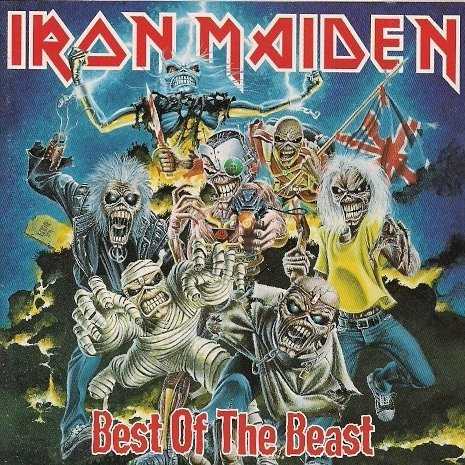 | Album: 12 of 27 Title: Best of the Beast Released: 1996-09-23 Tracks: 27 Duration: 2:29:33 Scroll: Up Down Top Bottom 25% 50% 75% Wikipedia AlbumCover | 1 Virus (06:13) 2 Sign of the Cross (11:17) 3 Man on the Edge (04:13) 4 Afraid to Shoot Strangers (06:49) 5 Be Quick or Be Dead (03:24) 6 Fear of the Dark (07:23) 7 Bring Your Daughter… to the Slaughter (04:44) 8 Holy Smoke (03:49) 9 The Clairvoyant (04:27) 10 Can I Play With Madness (03:32) 11 The Evil That Men Do (04:35) 12 Heaven Can Wait (07:21) 13 Wasted Years (05:07) 1 Rime of the Ancient Mariner (13:27) 2 Running Free (03:29) 3 2 Minutes to Midnight (06:01) 4 Aces High (04:31) 5 Where Eagles Dare (06:10) 6 The Trooper (04:12) 7 The Number of the Beast (04:51) 8 Run to the Hills (03:53) 9 Hallowed Be Thy Name (07:11) 10 Wrathchild (02:55) 11 Phantom of the Opera (07:07) 12 Sanctuary (03:16) 13 Strange World (05:24) 14 Iron Maiden (04:02) |
 | Album: 13 of 27 Title: Virtual XI Released: 1998-03-18 Tracks: 8 Duration: 53:14 Scroll: Up Down Top Bottom 25% 50% 75% Spotify Wikipedia Allmusic AlbumCover | 1 Futureal (02:56) 2 The Angel and the Gambler (09:52) 3 Lightning Strikes Twice (04:50) 4 The Clansman (08:59) 1 When Two Worlds Collide (06:17) 2 The Educated Fool (06:44) 3 Don’t Look to the Eyes of a Stranger (08:03) 4 Como estais amigos (05:30) |
| Virtual XI : Allmusic album Review : CMC International did provide a needed service by allowing metal bands past their prime an opportunity to release records. Most of these bands sold records, but in considerably smaller numbers than they did at the height of their career. For fans and the bands alike, CMC Internationals very presence was welcome, since it was likely that these bands -- including Iron Maiden -- wouldnt have had a chance to record otherwise. Unfortunately, that didnt necessarily mean that the bands needed to be recorded at this time. Take, for instance, Iron Maiden. After touring for over 20 years, the band had perfected their style, but all the surprise had been stripped from their sound. Furthermore, charismatic lead vocalist Bruce Dickinson had been replaced by Blaze Bayley, a competent but faceless vocalist, which only emphasized the fact that a band that defined a genre had become generic themselves. Nowhere is that more apparent than on Virtual XI, their second album for CMC. On the surface, theres nothing terribly wrong with the record, as it delivers all the crunching riffs and demonic horror of their best records. The problem is that theres nothing memorable about the hooks, riffs, or songs, and theres little visceral energy to the music or production. As a result, it sounds lifeless to all but the most devoted fan. And even those fans, pleased as they may be to have a new Maiden album, will admit that the group sounds tired. | ||
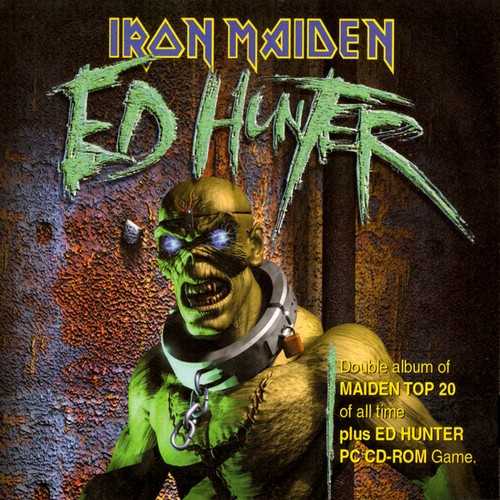 | Album: 14 of 27 Title: Ed Hunter Released: 1999-07 Tracks: 20 Duration: 1:43:30 Scroll: Up Down Top Bottom 25% 50% 75% Spotify Allmusic AlbumCover | 1 Iron Maiden (04:20) 2 The Trooper (04:12) 3 The Number of the Beast (04:51) 4 Wrathchild (02:55) 5 Futureal (02:56) 6 Fear of the Dark (07:18) 7 Be Quick or Be Dead (03:24) 8 2 Minutes to Midnight (06:01) 9 Man on the Edge (04:13) 10 Aces High (04:31) 11 The Evil That Men Do (04:35) 12 Wasted Years (05:07) 13 Powerslave (06:48) 14 Hallowed Be Thy Name (07:11) 1 Run to the Hills (03:53) 2 The Clansman (08:59) 3 Phantom of the Opera (07:07) 4 Killers (05:01) 5 Stranger in a Strange Land (05:44) 6 Tailgunner (04:15) |
| Ed Hunter : Allmusic album Review : Ed Hunter is a rather unique, fan-friendly three-CD set from British heavy metal heavyweights Iron Maiden. Two discs feature the bands best songs as chosen by fans on the official website. The running order of the 20 songs mirrors the vote ranking. Obvious favorites such as "The Trooper," "Run to the Hills," and "2 Minutes to Midnight" are included, but pay special attention to underrated tracks like "Powerslave," "Hallowed Be Thy Name," and "The Evil That Men Do." All of Iron Maidens studio albums are represented, as well as the beloved Live After Death. The third disc is the Ed Hunter shoot-em-up CD-ROM computer game. The object of the game is to pursue Iron Maidens skeleton mascot, Eddie, through worlds reflected in the bands songs and album covers. Ed Hunter will most likely appeal to diehards. Casual fans would probably be best served by either the one-disc or two-disc version of Best of the Beast. | ||
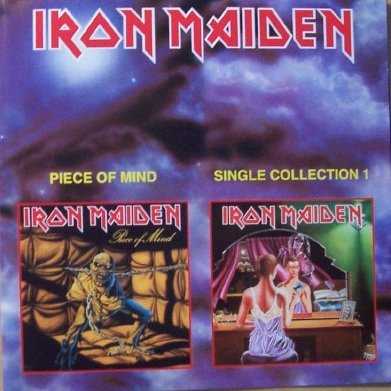 | Album: 15 of 27 Title: Piece of Mind / Single Collection 1 Released: 2000 Tracks: 17 Duration: 1:16:46 Scroll: Up Down Top Bottom 25% 50% 75% AlbumCover | 1 Where Eagles Dare (06:10) 2 Revelations (06:48) 3 Flight of Icarus (03:51) 4 Die With Your Boots On (05:28) 5 The Trooper (04:12) 6 Still Life (04:53) 7 Quest for Fire (03:41) 8 Sun and Steel (03:26) 9 To Tame a Land (07:27) 10 Sanctuary (03:16) 11 Burning Ambition (02:41) 12 Drifter (06:03) 13 I’ve Got the Fire (live) (03:14) 14 Twilight Zone (02:34) 15 Women in Uniform (03:10) 16 Invasion (02:38) 17 Phantom of the Opera (live) (07:10) |
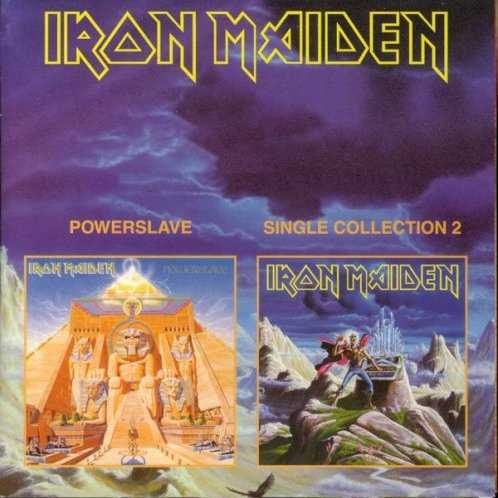 | Album: 16 of 27 Title: Powerslave / Single Collection 2 Released: 2000 Tracks: 13 Duration: 1:12:04 Scroll: Up Down Top Bottom 25% 50% 75% AlbumCover | 1 Aces High (04:31) 2 2 Minutes to Midnight (06:01) 3 Losfer Words (Big ’Orra) (04:15) 4 Flash of the Blade (04:05) 5 The Duellists (06:09) 6 Back in the Village (05:05) 7 Powerslave (07:13) 8 Rime of the Ancient Mariner (13:41) 9 Rainbow’s Gold (04:56) 10 King of Twilight (04:53) 11 I’ve Got the Fire (02:39) 12 Cross‐Eyed Mary (03:53) 13 Still Life (live) (04:37) |
 | Album: 17 of 27 Title: Brave New World Released: 2000-05-30 Tracks: 10 Duration: 1:07:01 Scroll: Up Down Top Bottom 25% 50% 75% Spotify Wikipedia Allmusic AlbumCover | 1 The Wicker Man (04:36) 2 Ghost of the Navigator (06:50) 3 Brave New World (06:18) 4 Blood Brothers (07:14) 5 The Mercenary (04:42) 6 Dream of Mirrors (09:21) 1 The Fallen Angel (04:00) 2 The Nomad (09:06) 3 Out of the Silent Planet (06:25) 4 The Thin Line Between Love & Hate (08:26) |
| Brave New World : Allmusic album Review : The return of Iron Maidens "classic" Dickinson/Harris/Murray/Smith/McBrain lineup (plus third guitarist Janick Gers) in 1999 led to an incredibly successful world tour that saw the New Wave of British Heavy Metal legends commanding stages with the same unmitigated power and authority as they had during their mid-80s heyday. But the question remained as to whether the reconstituted group would be able to carry this momentum into a studio setting and recapture the songwriting chops of its glory years. This question made Brave New World one of the most highly anticipated metal releases of 2000, and thankfully, the eventual answer to that question was a resounding "YES!" In fact, the album pretty much picked up right where the "classic" lineup had left off on 1988s Seventh Son of a Seventh Son: with a faithful rediscovery of Iron Maidens best-loved sonic aesthetic and compositional quirks, updated only insofar as was necessary to measure up to new-millennium recording standards. In every other respect (and much like Seventh Son of a Seventh Son), Brave New Worlds meticulously orchestrated three-guitar attack still allowed for a greater sense of space than early Maiden albums (as well as the use of subtle keyboard textures in a supporting role), while boasting a beefier, in-your-face mix à la Piece of Mind or Powerslave. The remarkable pipes of singer Bruce Dickinson actually seemed to have benefited from a less grueling touring schedule over the previous decade, and his renewed songwriting partnership with bassist Steve Harris (and other assorted bandmembers) yielded several new Maiden live standards such as punchy first single, "The Wicker Man," and the positively anthemic title track. Also worthy of special mention were Harris emotional solo copyright, "Blood Brothers," Adrian Smiths distinctive solo licks throughout "The Fallen Angel," and six-string stalwart Dave Murrays Arabian-flavored contributions to "The Nomad." These highlights notwithstanding, a more lucid appraisal revealed that Brave New World was no Number of the Beast, once the initial euphoria died down. But as comeback albums go, its excellence was undeniable, and announced not only Iron Maidens triumphant return, but an important turning point in heavy metals long, arduous climb back to respectability after years of critical abuse. | ||
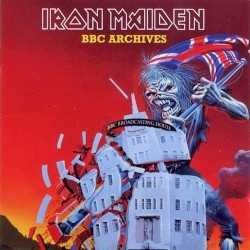 | Album: 18 of 27 Title: BBC Archives Released: 2002-11-04 Tracks: 28 Duration: 2:28:14 Scroll: Up Down Top Bottom 25% 50% 75% Wikipedia AlbumCover | 1 Iron Maiden (03:45) 2 Running Free (03:10) 3 Transylvania (04:02) 4 Sanctuary (03:44) 5 Wrathchild (03:31) 6 Run to the Hills (05:35) 7 Children of the Damned (04:48) 8 The Number of the Beast (05:28) 9 22 Acacia Avenue (06:36) 10 Transylvania (06:19) 11 The Prisoner (05:49) 12 Hallowed Be Thy Name (07:36) 13 Phantom of the Opera (07:01) 14 Iron Maiden (04:56) 1 Prowler (04:26) 2 Remember Tomorrow (05:59) 3 Killers (04:43) 4 Running Free (03:52) 5 Transylvania (04:48) 6 Iron Maiden (04:56) 7 Moonchild (05:43) 8 Wrathchild (03:00) 9 Infinite Dreams (05:51) 10 The Trooper (04:04) 11 Seventh Son of a Seventh Son (10:26) 12 The Number of the Beast (04:42) 13 Hallowed Be Thy Name (07:09) 14 Iron Maiden (06:00) |
 | Album: 19 of 27 Title: Edward the Great Released: 2002-11-05 Tracks: 16 Duration: 1:15:05 Scroll: Up Down Top Bottom 25% 50% 75% Wikipedia AlbumCover | 1 Run to the Hills (03:53) 2 The Number of the Beast (04:51) 3 Flight of Icarus (03:51) 4 The Trooper (04:12) 5 2 Minutes to Midnight (06:01) 6 Wasted Years (05:07) 7 Can I Play With Madness (03:32) 8 The Evil That Men Do (04:35) 9 The Clairvoyant (04:27) 10 Infinite Dreams (06:09) 11 Holy Smoke (03:49) 12 Bring Your Daughter… to the Slaughter (04:44) 13 Man on the Edge (04:13) 14 Futureal (02:56) 15 The Wicker Man (04:36) 16 Fear of the Dark (live, Rock in Rio) (08:04) |
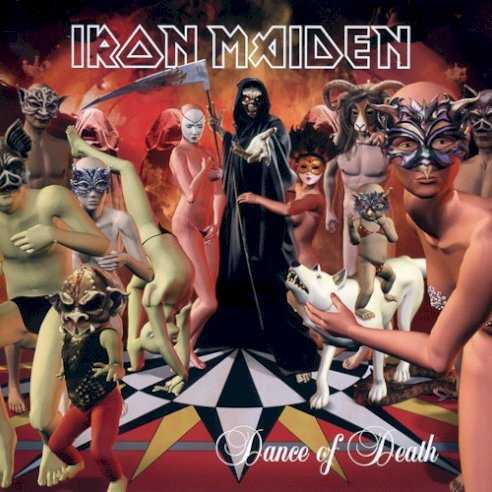 | Album: 20 of 27 Title: Dance of Death Released: 2003-09-03 Tracks: 11 Duration: 1:08:02 Scroll: Up Down Top Bottom 25% 50% 75% Spotify Wikipedia Allmusic AlbumCover | 1 Wildest Dreams (03:52) 2 Rainmaker (03:48) 3 No More Lies (07:21) 4 Montségur (05:50) 5 Dance of Death (08:36) 6 Gates of Tomorrow (05:12) 1 New Frontier (05:04) 2 Paschendale (08:28) 3 Face in the Sand (06:31) 4 Age of Innocence (06:10) 5 Journeyman (07:06) |
| Dance of Death : Allmusic album Review : Drummer Nicko McBrain kicks off Iron Maidens 13th studio record with an uncharacteristic one-two-three-four before launching into the rousing opener, "Wildest Dreams." This bar-band sensibility permeates Dance of Deaths first three refreshing yet unremarkable tracks before shifting into the more familiar fantasy rock of previous releases. That shift begins with the remarkable "Montsegur," a brutal, melodic assault that recalls the groups glory days and showcases lead singer Bruce Dickinson at his venom-spitting best. The anthemic "New Frontier" is a musical sibling to the bands 1982 classic "Number of the Beast" and eclipses any doubt about the bands ability to keep up with the phantom specter of age. Despite the dark imagery and the ferocity of the performances, theres a looseness to the record that conveys a surreal sense of fun. They enjoy playing together, and that more than anything shines through on old-fashioned rockers like "No More Lies" and "Gates of Tomorrow." No Iron Maiden album would be complete without a Dungeons and Dragons-style epic, and they deliver on the hammy title track and the lush closer, "Journeyman." The groups innate ability to consistently cater to its fans stubborn tastes, while maintaining a level of integrity that other veteran bands displace with unintentional Spinal Tap zeal, is a testament to its talent and experience. While the keyboard-heavy sound of their previous release, the excellent Brave New World, creeps into some of the more indulgent tracks, Dance of Death is a triumphant return to form for these heavy metal legends. | ||
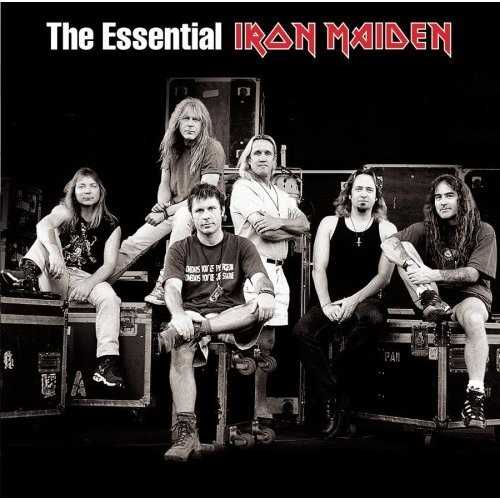 | Album: 21 of 27 Title: The Essential Iron Maiden Released: 2005-07-04 Tracks: 27 Duration: 2:28:00 Scroll: Up Down Top Bottom 25% 50% 75% Allmusic Wikipedia AlbumCover | 1 Paschendale (08:28) 2 Rainmaker (03:48) 3 The Wicker Man (04:36) 4 Brave New World (06:18) 5 Futureal (02:56) 6 The Clansman (08:59) 7 Sign of the Cross (11:17) 8 Man on the Edge (04:13) 9 Be Quick or Be Dead (03:24) 10 Fear of the Dark (live) (07:52) 11 Holy Smoke (03:49) 12 Bring Your Daughter… to the Slaughter (04:44) 13 The Clairvoyant (04:27) 1 The Evil That Men Do (04:35) 2 Wasted Years (05:07) 3 Heaven Can Wait (07:21) 4 2 Minutes to Midnight (06:01) 5 Aces High (04:31) 6 Flight of Icarus (03:51) 7 The Trooper (04:12) 8 The Number of the Beast (04:51) 9 Run to the Hills (03:53) 10 Wrathchild (02:55) 11 Killers (05:01) 12 Phantom of the Opera (07:07) 13 Running Free (live) (08:43) 14 Iron Maiden (live) (04:49) |
| The Essential Iron Maiden : Allmusic album Review : To be fair, any career-spanning retrospective of a band thats been around for nearly 30 years is going to contain a few duds, but to include nearly a whole discs worth is unforgivable, especially when the era its chronicling is not nearly as dire as the tracks would suggest. Iron Maiden are one of the few surviving New Wave of British Heavy Metal acts to not only hold on to their fan base, but to continuously put out new material that doesnt demolish the impact of the bands heydays. Both Judas Priest and Maiden brought in new lead singers for a while (bad idea), then came to their senses, re-formed, and most recently put out pretty great records -- Angel of Retribution and Dance of Death, respectively. While the second disc of Sanctuary Records The Essential Iron Maiden piles on the hits from 1980s Paul DiAnno-led self-titled debut straight through to 1988s Seventh Son of a Seventh Son without missing a beat, it misses the mark on the first, which focuses on the groups (already spotty enough) later years. The two Blaze Bayley releases aside, 1990s No Prayer for the Dying, 1992s Fear of the Dark, 2000s Brave New World, and 2004s Dance of Death had some essential material on them, but the compilers seem to have just chosen songs at random -- there is no need for anyone to have to hear "Bring Your Daughter...to the Slaughter" again -- resulting in a truly missed opportunity. The liner notes are nice enough and the inclusion of "Iron Maiden" from the upcoming live record/DVD Death on the Road is impressive, but there really isnt anything essential about the whole affair. | ||
![Allmusic album Review : 2003s Dance of Death marked the triumphant return of old-school Iron Maiden. Gone were the murky, over-produced set pieces that clogged 2000s Brave New World and in their place fell blistering slabs of Piece of Mind-era metal. That trend continues with their 14th full-length album, Matter of Life and Death, a more elaborate and meandering experience than Dance of Death, but a rewarding one for fans willing to indulge the groups occasional excess. At over 70 minutes, Matter of Life and Death is closer to 1988s woefully underrated Seventh Son of a Seventh Son than it is to Piece of Mind, but with far less keyboard tickling. Recorded live in the studio, epics like "Reincarnation of Benjamin Breeg," "Brighter Than a Thousand Suns," and the brutal "Longest Day" -- the whole record is a loosely-knit song cycle with war at its core -- exhume prog rock complexity and discipline yet manage to bristle with the kind of small-club intensity usually reserved for acts half their age. At just over four minutes, opener "Different World" -- a near twin of Dance of Deaths "Wildest Dreams" -- is the only cut that screams single, but its also the most misplaced. On a record that positions beloved avatar Eddy on top of a tank with a machine gun leading a weary troop of skeletal soldiers to their doom, any act of brevity, no matter how expertly crafted, sticks out like a saxophone solo. [Matter of Life and Death is also available with a bonus DVD that includes videos, live performances, and rehearsal footage.] a_matter_of_life_and_death](../../images/iron_maiden-a_matter_of_life_and_death.jpg) | Album: 22 of 27 Title: A Matter of Life and Death Released: 2006-08-28 Tracks: 10 Duration: 1:12:04 Scroll: Up Down Top Bottom 25% 50% 75% Spotify Wikipedia Allmusic AlbumCover | 1 Different World (04:18) 2 These Colours Don’t Run (06:52) 3 Brighter Than a Thousand Suns (08:46) 4 The Pilgrim (05:07) 5 The Longest Day (07:47) 6 Out of the Shadows (05:36) 7 The Reincarnation of Benjamin Breeg (07:22) 8 For the Greater Good of God (09:24) 9 Lord of Light (07:24) 10 The Legacy (09:22) |
| A Matter of Life and Death : Allmusic album Review : 2003s Dance of Death marked the triumphant return of old-school Iron Maiden. Gone were the murky, over-produced set pieces that clogged 2000s Brave New World and in their place fell blistering slabs of Piece of Mind-era metal. That trend continues with their 14th full-length album, Matter of Life and Death, a more elaborate and meandering experience than Dance of Death, but a rewarding one for fans willing to indulge the groups occasional excess. At over 70 minutes, Matter of Life and Death is closer to 1988s woefully underrated Seventh Son of a Seventh Son than it is to Piece of Mind, but with far less keyboard tickling. Recorded live in the studio, epics like "Reincarnation of Benjamin Breeg," "Brighter Than a Thousand Suns," and the brutal "Longest Day" -- the whole record is a loosely-knit song cycle with war at its core -- exhume prog rock complexity and discipline yet manage to bristle with the kind of small-club intensity usually reserved for acts half their age. At just over four minutes, opener "Different World" -- a near twin of Dance of Deaths "Wildest Dreams" -- is the only cut that screams single, but its also the most misplaced. On a record that positions beloved avatar Eddy on top of a tank with a machine gun leading a weary troop of skeletal soldiers to their doom, any act of brevity, no matter how expertly crafted, sticks out like a saxophone solo. [Matter of Life and Death is also available with a bonus DVD that includes videos, live performances, and rehearsal footage.] | ||
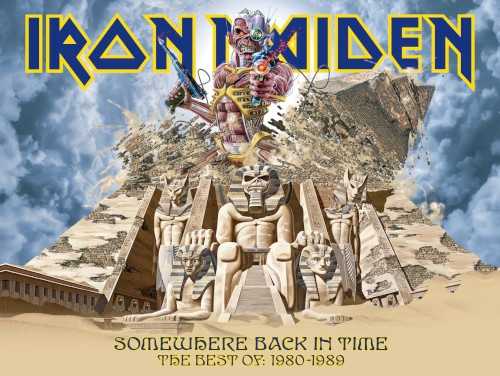 | Album: 23 of 27 Title: Somewhere Back in Time: The Best of 1980–1989 Released: 2008-04-07 Tracks: 15 Duration: 1:11:05 Scroll: Up Down Top Bottom 25% 50% 75% Spotify Allmusic Wikipedia AlbumCover | 1 Intro: Churchill’s Speech (00:49) 2 Aces High (04:39) 3 2 Minutes to Midnight (06:01) 4 The Trooper (04:12) 5 Wasted Years (05:07) 6 Children of the Damned (04:34) 7 The Number of the Beast (04:51) 8 Run to the Hills (03:53) 9 Phantom of the Opera (07:20) 10 The Evil That Men Do (04:35) 11 Wrathchild (03:05) 12 Can I Play With Madness (03:32) 13 Powerslave (06:48) 14 Hallowed Be Thy Name (07:11) 15 Iron Maiden (04:20) |
| Somewhere Back in Time: The Best of 1980–1989 : Allmusic album Review : Heavy metal stalwarts Iron Maiden have yet to receive the "royal treatment" when it comes to the anthology section of their surprisingly consistent catalog (well just let the two records with Bruce Dickinsin replacement Blaze Bayley disappear into the ether), but Sonys Somewhere Back in Time: The Best of 1980-1989 provides listeners with a semi-decent set of heavy metal crib notes from the groups most popular era. Like previous compilations, the inclusion of cuts like "Run to the Hills," "Number of the Beast," "2 Minutes to Midnight," and "The Trooper" is a no-brainer, and great album tracks like "Powerslave" and "Evil That Men Do" make for a fun listen, but one has to question the validity of populating a greatest-hits collection with four tracks culled from a live performance. Love them or hate them, when it comes to live albums, 1985s Live After Death is one of the better ones out there, and theres no denying the electricity that runs through "Aces High" and "Wrathchild," but why deny first-time listeners the fine studio versions of both, especially Paul DiAnnos "Phantom of the Opera" and "Iron Maiden?" Also, where are all of the tracks from 1983s landmark Piece of Mind album? For such a beloved metal institution, there are precious few quality retrospectives and a whole bunch of merely adequate ones, guess which camp Somewhere Back in Time falls into? | ||
![Allmusic album Review : When Iron Maidens classic lineup famously reunited in the year 2000, their first new album, the quite excellent Brave New World, neatly reconnected both musicians and fans with the bands heritage, while simultaneously promising a prosperous future still to come. However, their next two efforts didnt fare quite as well, and whether Maiden was choosing to repeat the same moves without as much imagination or consistency on 2003s Dance of Death, or becoming bogged down in tiresome prog rock excess on 2006s desultory A Matter of Life and Death, it seemed that neither playing it safe nor taking risks was a surefire recipe for success anymore. And so the heavy metal icons took an extra year -- for them, a record-breaking four -- to work on their fourth post-reunion opus, and 15th career studio album overall, 2010s The Final Frontier, which, like many of their original mid-80s classics, was recorded at legendary Compass Point Studios in the Bahamas, and aimed to reestablish an ideal balance of past and future, familiarity and freshness, complexity and immediacy. By and large, this is accomplished, and not just because of the futuristic themes spread across these songs, either -- nor the science fiction imagery used throughout the albums artwork, including the latest metamorphosis of the bands inseparable mascot, Eddie, this time into a hulking, green alien predator. No, there really is an unquestionable freshness about the futuristic themes and novel sonics explored by the intriguing percussive warm-up, "Satellite 15," which leads straight into the anthemic, arena-friendly opening title track; the muscularly riffed "Mother of Mercy," which recalls Bruce Dickinsons better mid-90s solo efforts; and the remarkable "Coming Home," which is easily Iron Maidens most convincingly executed semi-ballad since Fear of the Darks "Wasting Love," and probably better to boot. The albums first half is rounded out by the surprisingly complex and cerebral first single "El Dorado," which was clearly written with "2 Minutes to Midnight" as a template (but isnt that good), before finally striking out with the efficient but ultimately somewhat forgettable speedster "The Alchemist," yet, all in all, this is a very impressive start. Too bad The Final Frontiers second half doesnt hold up so well, being stacked in worrisome fashion with five straight, longish compositions ranging from eight to eleven minutes in length. Even by Maiden standards, this is a tall order for fans to cope with (again!), and, sure enough, top marks are only deserved by the evocative Arthurian fantasy "Isle of Avalon," which is first out of the gate and captures all of the majesty and power youd expect of an Iron Maiden epic, despite being no "Hallowed Be Thy Name" or "Rhyme of the Ancient Mariner" -- a "Paschendale," maybe. The remaining five-song monoliths produce only isolated moments of excellence and, amazingly, all begin in suspiciously similar fashion: via quietly plucked, déjà vu-inducing melodies framed by synthesizers before heading off on their individual, long-winded journeys. The "moments" include a strikingly aggressive riff sequence and reminisces of Somewhere in Time contained on "Starblind," and the vaguely psychedelic harmonies nestled somewhere deep within "The Man Who Would Be King," whereas "The Talisman" and Gaelic-inspired "When the Wild Wind Blows" merely recycle spare parts, for the most part, cherry-picked and reassembled from across the Maiden canon. This late dip in quality at the mercy of the bands more-is-more philosophy definitely leaves one pining for the days when heavier, punchier, and just plain shorter songs held equal appeal for Steve Harris and company; but, in good ways and bad ways, by hook or by crook, The Final Frontier still brings Iron Maiden closer to their aesthetic legacy and triumphant year 2000 rebirth than its two predecessors. And, at this stage in their career, Iron Maiden knows that nothing is more important than giving fans -- of all stripes -- what they want and expect. Why mess with a winning team, after all? [The Final Frontiers special -- aka "Mission" -- Edition was delivered with bonus content in a deluxe package outfitted to resemble a spaceship porthole.] the_final_frontier](../../images/iron_maiden-the_final_frontier.jpg) | Album: 24 of 27 Title: The Final Frontier Released: 2010-08-13 Tracks: 10 Duration: 1:16:34 Scroll: Up Down Top Bottom 25% 50% 75% Spotify Wikipedia Allmusic AlbumCover | 1 Satellite 15… The Final Frontier (08:40) 2 El Dorado (06:49) 3 Mother of Mercy (05:20) 4 Coming Home (05:52) 5 The Alchemist (04:29) 6 Isle of Avalon (09:06) 7 Starblind (07:48) 8 The Talisman (09:03) 9 The Man Who Would Be King (08:28) 10 When the Wild Wind Blows (10:59) |
| The Final Frontier : Allmusic album Review : When Iron Maidens classic lineup famously reunited in the year 2000, their first new album, the quite excellent Brave New World, neatly reconnected both musicians and fans with the bands heritage, while simultaneously promising a prosperous future still to come. However, their next two efforts didnt fare quite as well, and whether Maiden was choosing to repeat the same moves without as much imagination or consistency on 2003s Dance of Death, or becoming bogged down in tiresome prog rock excess on 2006s desultory A Matter of Life and Death, it seemed that neither playing it safe nor taking risks was a surefire recipe for success anymore. And so the heavy metal icons took an extra year -- for them, a record-breaking four -- to work on their fourth post-reunion opus, and 15th career studio album overall, 2010s The Final Frontier, which, like many of their original mid-80s classics, was recorded at legendary Compass Point Studios in the Bahamas, and aimed to reestablish an ideal balance of past and future, familiarity and freshness, complexity and immediacy. By and large, this is accomplished, and not just because of the futuristic themes spread across these songs, either -- nor the science fiction imagery used throughout the albums artwork, including the latest metamorphosis of the bands inseparable mascot, Eddie, this time into a hulking, green alien predator. No, there really is an unquestionable freshness about the futuristic themes and novel sonics explored by the intriguing percussive warm-up, "Satellite 15," which leads straight into the anthemic, arena-friendly opening title track; the muscularly riffed "Mother of Mercy," which recalls Bruce Dickinsons better mid-90s solo efforts; and the remarkable "Coming Home," which is easily Iron Maidens most convincingly executed semi-ballad since Fear of the Darks "Wasting Love," and probably better to boot. The albums first half is rounded out by the surprisingly complex and cerebral first single "El Dorado," which was clearly written with "2 Minutes to Midnight" as a template (but isnt that good), before finally striking out with the efficient but ultimately somewhat forgettable speedster "The Alchemist," yet, all in all, this is a very impressive start. Too bad The Final Frontiers second half doesnt hold up so well, being stacked in worrisome fashion with five straight, longish compositions ranging from eight to eleven minutes in length. Even by Maiden standards, this is a tall order for fans to cope with (again!), and, sure enough, top marks are only deserved by the evocative Arthurian fantasy "Isle of Avalon," which is first out of the gate and captures all of the majesty and power youd expect of an Iron Maiden epic, despite being no "Hallowed Be Thy Name" or "Rhyme of the Ancient Mariner" -- a "Paschendale," maybe. The remaining five-song monoliths produce only isolated moments of excellence and, amazingly, all begin in suspiciously similar fashion: via quietly plucked, déjà vu-inducing melodies framed by synthesizers before heading off on their individual, long-winded journeys. The "moments" include a strikingly aggressive riff sequence and reminisces of Somewhere in Time contained on "Starblind," and the vaguely psychedelic harmonies nestled somewhere deep within "The Man Who Would Be King," whereas "The Talisman" and Gaelic-inspired "When the Wild Wind Blows" merely recycle spare parts, for the most part, cherry-picked and reassembled from across the Maiden canon. This late dip in quality at the mercy of the bands more-is-more philosophy definitely leaves one pining for the days when heavier, punchier, and just plain shorter songs held equal appeal for Steve Harris and company; but, in good ways and bad ways, by hook or by crook, The Final Frontier still brings Iron Maiden closer to their aesthetic legacy and triumphant year 2000 rebirth than its two predecessors. And, at this stage in their career, Iron Maiden knows that nothing is more important than giving fans -- of all stripes -- what they want and expect. Why mess with a winning team, after all? [The Final Frontiers special -- aka "Mission" -- Edition was delivered with bonus content in a deluxe package outfitted to resemble a spaceship porthole.] | ||
 | Album: 25 of 27 Title: From Fear to Eternity: The Best of 1990–2010 Released: 2011-06-06 Tracks: 23 Duration: 2:33:55 Scroll: Up Down Top Bottom 25% 50% 75% Spotify Wikipedia Allmusic AlbumCover | 1 The Wicker Man (04:36) 2 Holy Smoke (03:49) 3 El Dorado (06:49) 4 Paschendale (08:27) 5 Different World (04:18) 6 Man on the Edge (live) (04:32) 7 The Reincarnation of Benjamin Breeg (07:22) 8 Blood Brothers (07:14) 9 Rainmaker (03:48) 10 Sign of the Cross (live) (10:51) 11 Brave New World (06:18) 12 Fear of the Dark (live) (07:50) 1 Be Quick or Be Dead (03:24) 2 Tailgunner (04:15) 3 No More Lies (07:21) 4 Coming Home (05:52) 5 The Clansman (live) (09:30) 6 For the Greater Good of God (09:24) 7 These Colours Don’t Run (06:52) 8 Bring Your Daughter… to the Slaughter (04:44) 9 Afraid to Shoot Strangers (06:56) 10 Dance of Death (08:37) 11 When the Wild Wind Blows (10:59) |
| From Fear to Eternity: The Best of 1990–2010 : Allmusic album Review : From Fear to Eternity: The Best of 1990-2010 collects 23 tracks over the span of two discs from the venerable British heavy metal legends. The first anthology to cover the band’s post-halcyon days, it’s remarkable how seamless the transition was. Unlike other acts that left their handprints in the cement in the late 70s and 80s, Iron Maiden never really lost steam, despite a mid-90s shake-up that saw iconic lead singer Bruce Dickinson swapped out with Wolfsbane vocalist Blaze Bayley for two albums. The addition of keyboards, a controversial, late-80s move that split some fans upon the releases of Somewhere in Time (1986) and Seventh Son of a Seventh Son (1988), proved largely tasteful and subtle, and did little to hinder their signature blend of fantasy-fueled symphonic metal and straight-up English hard rock. Culled from eight studio albums (including the pair of Bayley offerings), the songs on From Fear to Eternity may not reach the dizzying heights of the band’s Piece of Mind/Number of the Beast heyday, but stand-out cuts like “The Wicker Man,” “Different World,” “Tailgunner,” “Dance of Death,” and “Brave New World” bristle with the energy and conviction of a group 20 years younger. Dickinsons voice is apparently indestructible, and the triple-guitar attack, held down to the mat by the incomparable Steve Harris (founder/bassist), remains a veritable master class in heavy metal picking. Its an impressive feat, to say the least, but what stands out the most is the fact the band has amassed the kind of loyal, age-defying fan base that virtually guarantees a lifetime of sold-out world tours, a feat they managed to pull off without ever selling themselves out. | ||
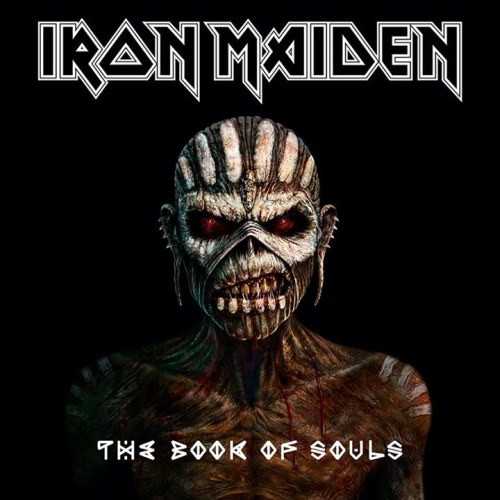 | Album: 26 of 27 Title: The Book of Souls Released: 2015-09-04 Tracks: 11 Duration: 1:32:14 Scroll: Up Down Top Bottom 25% 50% 75% Spotify Wikipedia Allmusic AlbumCover | 1 If Eternity Should Fail (08:28) 2 Speed of Light (05:01) 3 The Great Unknown (06:37) 4 The Red and the Black (13:33) 5 When the River Runs Deep (05:52) 6 The Book of Souls (10:28) 1 Death or Glory (05:12) 2 Shadows of the Valley (07:32) 3 Tears of a Clown (04:58) 4 The Man of Sorrows (06:27) 5 Empire of the Clouds (18:01) |
| The Book of Souls : Allmusic album Review : To say that Iron Maidens The Book of Souls was ardently anticipated would be a vast understatement. Though it was (mostly) finished in 2014, vocalist Bruce Dickinsons cancer diagnosis and treatment delayed its release until he was medically cleared. While 2006s A Matter of Life and Death and 2010s The Final Frontier showcased longer songs, Book of Souls is epic by comparison. Their first double album, its 92 minutes long, and three of its 11 tracks are over ten minutes. Steve Harris contributed one solo composition, and co-wrote six tracks with various bandmates. Dickinson -- for the first time since Powerslave -- wrote two solo tunes, the albums bookends, and collaborated on two more. The music is cleanly divided between the two discs. The first is tight; it offers a bit of everything that makes Iron Maiden...well, Iron Maiden. It is seemingly self-contained. Dickinsons "If Eternity Should Fail" is an impressive showcase for his voice. Its dark intro and atmospherics are eventually transformed into one of the heaviest tunes Maidens recorded in a digs age, but he climbs above the sonic mass. "Speed of Light" is a burner. Dickinsons fury is accompanied by a rockarolla riff, soaring metal guitar fills, and Nicko McBrains grooving drums. Harris 13-minute "The Red and the Black" has a martial tempo and chant that recalls "Rime Of The Ancient Mariner." Its followed by "When the River Runs Deep," a chugging hard rocker with all three guitarists challenging one another. The title cut is theatrical, as acoustic guitar and a sparse synth are filled out with a knotty riff and solo breaks, emerging as a slower, heavier headbanger. By contrast, disc two is structured almost narratively; it slowly enlarges and expands to serve an unexpected conclusion. Opener "Death or Glory" is another crowd-catcher as Dickinson soars above thudding drums and guitar choruses redolent of Thin Lizzy. "Shadows of the Valley" is the only clunker. Its dull and predictable, a minor distraction that doesnt measure up to the sets ambition. "Tears of a Clown," written by Harris and Dave Murray, is for Robin Williams. Its a clamorous rocker, yet the lyrics and melody are simultaneously empathic and disconsolate. "The Man of Sorrows" follows expertly, progressing from meandering ballad to theatrical hard rock. Dickinsons 18-minute "Empire of the Clouds" is about the R101 airship disaster of 1930. Its Maidens longest song, but a grand conclusion. He plays majestic classical piano throughout, as tasteful, biting guitars create a complementary melodic labyrinth amid swelling orchestral strings. They add texture while McBrains swinging drums add drama. Its a heavy metal suite, unlike anything in their catalog. Producer Kevin Shirley does a stellar job capturing an "in studio" sound that allows for spacious dynamics and warmth without artifical mass. Who would have thought that after decades Iron Maiden would have an album as fine (let alone as long) as The Book of Souls in them? With repeated listening it earns shelf space with their finest records. | ||
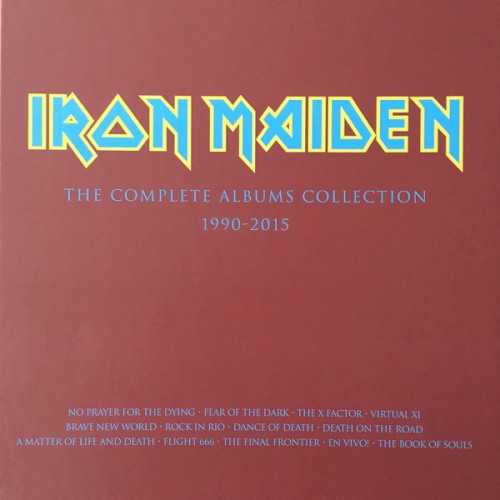 | Album: 27 of 27 Title: The Complete Albums Collection 1990-2015 Released: 2017-05-19 Tracks: 22 Duration: 1:43:01 Scroll: Up Down Top Bottom 25% 50% 75% Allmusic AlbumCover | 1 Tailgunner (04:13) 2 Holy Smoke (03:49) 3 No Prayer for the Dying (04:23) 4 Public Enema Number One (04:13) 5 Fates Warning (04:12) 6 The Assassin (04:35) 7 Run Silent Run Deep (04:35) 8 Hooks in You (04:08) 9 Bring Your Daughter… to the Slaughter (04:44) 10 Mother Russia (05:32) 1 Be Quick or Be Dead (03:23) 2 From Here to Eternity (03:38) 3 Afraid to Shoot Strangers (06:56) 4 Fear Is the Key (05:35) 5 Childhood’s End (04:40) 6 Wasting Love (05:50) 1 The Fugitive (04:54) 2 Chains of Misery (03:37) 3 The Apparition (03:54) 4 Judas Be My Guide (03:08) 5 Weekend Warrior (05:39) 6 Fear of the Dark (07:15) |